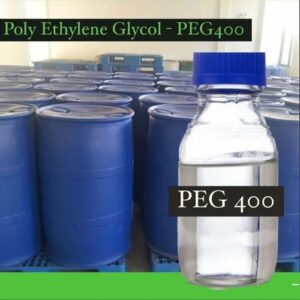Product Description: PEG 400 (Polyethylene Glycol 400)
PEG 400, or Polyethylene Glycol 400, is a versatile, water-soluble polymer that is widely used in various industries due to its unique properties. It is a clear, colorless, and odorless liquid that is non-toxic and non-irritating, making it suitable for a wide range of applications. PEG 400 is known for its excellent solubility in water and organic solvents, as well as its ability to act as a humectant, emulsifier, and lubricant. Its low molecular weight allows for easy absorption and penetration, making it a popular choice in pharmaceuticals, cosmetics, and food products.
Key Uses of PEG 400:
- Pharmaceuticals: Used as a solvent, plasticizer, and excipient in drug formulations.
- Cosmetics and Personal Care: Acts as a moisturizer, emulsifier, and thickening agent in creams, lotions, and gels.
- Food Industry: Serves as a food additive and humectant to retain moisture in food products.
- Industrial Applications: Utilized as a lubricant, surfactant, and in the production of various chemical formulations.
- Research and Development: Employed in laboratory settings for various applications, including drug delivery systems.
Technical Data
| Property | Value |
|---|---|
| Chemical Name | Polyethylene Glycol 400 |
| Molecular Weight | ~400 g/mol |
| Appearance | Clear, colorless liquid |
| Density | 1.125 g/cm³ |
| Viscosity | 50-100 mPa·s (at 25°C) |
| Solubility | Soluble in water and alcohols |
| pH (1% solution) | 6.0 – 7.0 |
| Boiling Point | 197 °C |
| Flash Point | 230 °C |
| Toxicity | Non-toxic |
| Storage Conditions | Store in a cool, dry place |
Summary
PEG 400 is a highly versatile compound with a wide range of applications across various industries. Its unique properties, such as solubility, non-toxicity, and emulsifying capabilities, make it an essential ingredient in pharmaceuticals, cosmetics, food products, and industrial applications. Understanding its technical data and uses can help in selecting the right formulation for specific needs.

